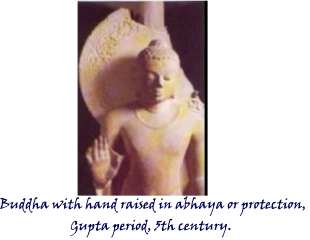World > India > Museums > Sarnath Museum
The Archaeological Museum, Sarnath

There are something very beautiful and moving about a visit to Sarnath, like visiting the garden of Gethesmane in Jerusalem or Mount Sinai where Moses received the Ten commandments. It is not difficult to imagine a quite, peaceful, shady forest grove here, where deer roamed freely and birds went about their noisy business.
The first sculpture to be encountered in the museum is the huge lion capital (2.31 m in height) that was adopted as the emblem of the Republic of India. This capital once surmounted a pillar and is said to have been erected by the Mauryan emperor Ashoka (second century BC) to mark the site where the Buddha preached and started the first monastic order of Buddhism. The capital comprises four lions facing the cardinal directions, each with a tidy mass of thickly curled mane, and a mouth that curls in a snarl (or grin) to ward off evil. Below, on the abacus, are four wheels, the symbols of the law of dharma, progress and movement. Separating the wheels are a bull, an elephant, a lion and a horse- symbols of devotion, strength, power and speed respectively. Below the abacus (the flat upper part of the capital), a huge inverted lotus bugles out to join the pillar below. Emperor Ashoka is also said to have built a stupa here - the brick construction of this shrine is at the core of the Dhamekh Stupa at Sarnath - to commemorate the place where Buddha sat to deliver his first lesson.
Towards the left-hand wall of the entrance hall are two seated figures of the Buddha, one of which, entitled Buddha Preaching Law (fifth century), sums up the historic events of Sarnath. The Buddha is seated, his hands in the gesture of the 'turning of the wheel of law'. Below his seat is a wheel, together with some of his followers and early disciples, and some deer to indicate the Deer Park of Sarnath. The wheel of law-the dharma Chakra - became a symbols for the Buddha's teaching. The Buddha's body is framed by an ornate halo, reflecting the designs to be found on the Gupta stone renovations of the Dhamekh Stupa at Sarnath.
Two colossal statues frame the Lion capital, one of which is a Bodhisattva of the first to second centuries. The sculpture is massive, in the style of early Kushana art. The figure is draped in a fine toga caught at the waist by a sash; the moving body is clearly visible under the fabric, and between its legs is a tiny little lion.
Around the room and along the gallery to the right are several figures of the Buddha, standing with one arm raised in the gesture of abhaya (protection, reassurance and blessing). It is a though during the Gupta period, when Buddhism received royal patronage, a craft center developed here at Sarnath, akin to a factory, producing a number of similar figures is well proportioned, slim and elongated. The Gupta style of carving, having mastered the technique, brought to the Buddha's youthful face an expression of peace and inner tranquility. The tight curls on his head, and the topknot, arched eyebrows, the half-closed, meditative eyes, the perfect nose and unselfconscious mouth are carved in perfect proportion, so an not to suggest even the slightest glimmer of action or loss of control. It is the face of peace, that reflects a tranquil mind and a gentle philosophy.
The main exhibit includes one of the earliest images of Buddha. It also has the prized Ashokan pillar and a large collection of figures and sculptures from the Mauryan, Kushan and Gupta periods. Also on display at the museum are several fragments of Hindu sculptures, parts of the decorated buildings and monasteries, tools and implements, and terracotta's excavated from the site.
The Archaeological survey of India has some publications on Sarnath that are inexpensive and very reliable. These can be purchased at the ticket office, at the entrance gate of the museum.
The Archaeological Museum, Sarnath, Varanasi, Uttar Pradesh.
Hours : 10 am-4.30 pm every day except on Fridays and Government holidays.
Admission : Same ticket for the museum and site.
Suggested viewing time : an hour, including a walk around the excavations at Sarnath. Sarnath is 10 km from Varanasi.

